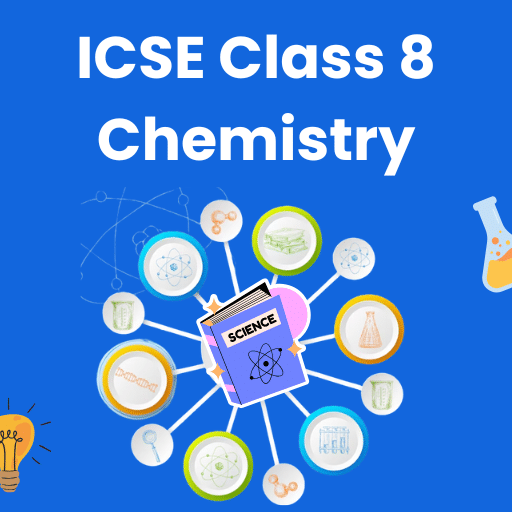
|
PARTNER COURSE
Chemistry Class 8 ICSEKds Coaching · Last updated on Oct 09, 2025 |
Chemistry Class 8 ICSE Study Material
Trending Courses for Class 8
Chemistry Class 8 ICSE CBSE Exam Pattern 2025-2026
Chemistry Class 8 ICSE Exam Pattern for Class 8
The Chemistry exam for Class 8 under the ICSE (Indian Certificate of Secondary Education) curriculum is designed to evaluate students' understanding of fundamental concepts in chemistry. Below is a detailed overview of the exam pattern, which will help students prepare effectively.
1. Exam Structure
- Total Marks: The Chemistry exam is typically conducted for a total of 80 marks.
- Duration: The exam duration is usually 2 hours.
2. Question Types
- Multiple Choice Questions (MCQs): These questions assess basic knowledge and understanding of concepts.
- Short Answer Questions: These require concise answers, focusing on key points and definitions.
- Long Answer Questions: These test deeper understanding and application of concepts, often requiring detailed explanations or calculations.
3. Syllabus Coverage
- Basic Concepts of Chemistry: Fundamental principles, laws, and terminologies.
- Structure of Atoms: Understanding atomic structure and models.
- Periodic Table: Familiarity with elements, groups, and periods.
- Chemical Reactions: Types of reactions, balancing equations, and energy changes.
- Acids, Bases, and Salts: Characteristics, properties, and examples.
- Mixtures and Compounds: Differences and methods of separation.
4. Internal Assessment
- Practical Work: Practical exams and lab work contribute to the overall assessment.
- Projects and Assignments: Regular projects and assignments may also be part of internal evaluation.
5. Preparation Tips
- Understand Concepts: Focus on grasping the fundamental principles rather than rote memorization.
- Practice Regularly: Solve previous years’ question papers and sample papers to familiarize yourself with the exam format.
- Revise Thoroughly: Regular revision of topics covered in the syllabus is crucial for retention.
- Engage in Group Studies: Discussing topics with peers can enhance understanding and clarify doubts.
By following the above guidelines and understanding the exam pattern, students can prepare effectively for their Chemistry Class 8 ICSE examination.
Chemistry Class 8 ICSE Syllabus 2025-2026 PDF Download
Class 8 Chemistry Syllabus
This detailed syllabus for Class 8 Chemistry under the ICSE curriculum covers essential topics that provide a foundation for understanding the principles of chemistry. Below are the key areas of study:
Class 8 Matter
- Definition and Properties: Understanding what constitutes matter, its properties, and classification into solids, liquids, and gases.
- States of Matter: Exploring the characteristics and behavior of different states of matter.
- Changes in Matter: Discussing physical and chemical changes in matter.
Class 8 Physical and Chemical Changes
- Physical Changes: Identifying and understanding examples of physical changes in daily life.
- Chemical Changes: Exploring chemical reactions and the signs of a chemical change.
- Comparison: Distinguishing between physical and chemical changes.
Class 8 Elements, Compounds and Mixtures
- Elements: Definition and examples of elements as pure substances.
- Compounds: Understanding compounds and their formation through chemical means.
- Mixtures: Differentiating between homogeneous and heterogeneous mixtures.
Class 8 Atomic Structure
- Basic Concepts: Introduction to atoms, molecules, and ions.
- Components: Understanding protons, neutrons, and electrons.
- Atomic Number and Mass Number: Learning about atomic numbers, mass numbers, and their significance.
Class 8 Language of Chemistry
- Chemical Symbols: Introduction to chemical symbols and their importance.
- Chemical Formulas: Understanding how to write and interpret chemical formulas.
- Balancing Equations: Learning the basics of balancing chemical equations.
Class 8 Chemical Reactions
- Types of Reactions: Exploring different types of chemical reactions including synthesis, decomposition, single replacement, and double replacement.
- Factors Affecting Reactions: Understanding how temperature, concentration, and catalysts affect reaction rates.
- Energy Changes: Discussing exothermic and endothermic reactions.
Class 8 Hydrogen
- Properties of Hydrogen: Learning about the physical and chemical properties of hydrogen.
- Uses of Hydrogen: Discussing the various applications of hydrogen in industries and daily life.
- Hydrogen Compounds: Exploring common compounds of hydrogen.
Class 8 Water
- Properties of Water: Understanding the unique properties of water.
- Importance of Water: Discussing the role of water in sustaining life.
- Water Cycle: Learning about the water cycle and its significance.
Class 8 Carbon and Its Compounds
- Properties of Carbon: Introduction to the properties and allotropes of carbon.
- Hydrocarbons: Understanding saturated and unsaturated hydrocarbons.
- Functional Groups: Learning about various functional groups in organic chemistry.
This syllabus for Class 8 Chemistry is designed to engage students in the fascinating world of chemistry, encouraging critical thinking and practical application of scientific concepts.
This course is helpful for the following exams: Class 8
How to Prepare Chemistry Class 8 ICSE?
How to Prepare Chemistry Class 8 ICSE for Class 8?
Preparing for Chemistry Class 8 ICSE can be an exciting journey filled with discovery and learning. Here are some effective strategies to ensure you grasp the key concepts and excel in your studies:
1. Understand the Syllabus
Familiarize yourself with the Chemistry Class 8 ICSE syllabus. Knowing the topics covered will help you allocate your study time effectively.
2. Gather Study Materials
Make sure you have access to quality study materials. Textbooks, reference books, and Chemistry Class 8 ICSE notes should be your go-to resources.
3. Create a Study Schedule
Develop a study plan that dedicates specific time blocks for Chemistry Class 8 ICSE topics. Consistent study habits are vital for mastering the concepts.
4. Focus on Practical Applications
Chemistry is not just theoretical. Engage in experiments and practical applications related to the Chemistry Class 8 ICSE curriculum. This hands-on experience reinforces your understanding.
5. Practice Regularly
Regularly solving sample questions and past papers related to Chemistry Class 8 ICSE will enhance your problem-solving skills. This practice is crucial for exam success.
6. Use Visual Aids
Utilize charts, diagrams, and videos to visualize complex concepts in Chemistry Class 8 ICSE. Visual aids can make studying more engaging and easier to understand.
7. Join Study Groups
Collaborate with classmates or friends in study groups. Discussing and explaining Chemistry Class 8 ICSE topics to others can deepen your understanding.
8. Seek Help When Needed
If you find certain topics challenging, don’t hesitate to ask for help. Teachers, tutors, or online resources dedicated to Chemistry Class 8 ICSE can clarify your doubts.
9. Revise Regularly
Regular revision is critical. Revisit each topic of Chemistry Class 8 ICSE periodically to reinforce your memory and understanding.
10. Stay Curious and Motivated
Lastly, maintain a curious and motivated mindset. Enjoy the learning process of Chemistry Class 8 ICSE and explore the wonders of science around you.
By following these strategies, you can effectively prepare for Chemistry Class 8 ICSE and build a solid foundation for future studies. Happy studying!
Importance of Chemistry Class 8 ICSE
Importance of Chemistry Class 8 ICSE Course for Class 8
Chemistry is a vital branch of science that explores the composition, structure, and properties of matter. For Class 8 students under the ICSE curriculum, the Chemistry course plays a crucial role in laying a strong foundation for future studies in science. Here’s why the Chemistry Class 8 ICSE course is essential:
1. Fundamental Concepts of Matter
Understanding the basic concepts of matter is key to grasping more complex scientific ideas in higher classes. This course introduces students to:
- The states of matter (solid, liquid, gas)
- The properties of different substances
- Atoms and molecules
2. Development of Analytical Skills
The study of Chemistry encourages critical thinking and analytical skills. Students learn to:
- Conduct experiments safely
- Observe and record results accurately
- Analyze data and draw conclusions
3. Real-World Applications
Chemistry is not just theoretical; it has practical applications in everyday life. This course helps students connect science with the real world by:
- Understanding the chemistry behind cooking and food preservation
- Exploring the chemical processes in environmental science
- Realizing the role of chemistry in health and medicine
4. Preparing for Future Studies
Chemistry serves as a stepping stone for more advanced topics in science. The Class 8 ICSE course prepares students for:
- Higher-level Chemistry in Class 9 and beyond
- Interdisciplinary subjects that combine chemistry with biology and physics
- Competitive examinations in the future
5. Encouraging Curiosity and Innovation
The course fosters curiosity, encouraging students to ask questions and seek answers. It inspires:
- Creative thinking in scientific problem-solving
- Innovation through hands-on experiments and projects
- A lifelong interest in science and exploration
6. Building a Strong Knowledge Base
A solid understanding of Chemistry in Class 8 equips students with:
- Essential vocabulary and concepts for future education
- Confidence to tackle challenging topics in science
- A comprehensive foundation for understanding complex scientific theories
In conclusion, the Chemistry Class 8 ICSE course provided by EduRev is not just about learning formulas and reactions; it is about nurturing a scientific mindset, encouraging exploration, and preparing students for a world where science plays a critical role in everyday life. Embracing this course will undoubtedly benefit students as they progress in their academic journey.
Chemistry Class 8 ICSE FAQs
| 1. What are the basic concepts of chemistry that Class 8 ICSE students should know? |  |
| 2. What is an element in chemistry? |  |
| 3. How do compounds differ from mixtures? |  |
| 4. What is the significance of the periodic table? |  |
| 5. What are physical and chemical changes? |  |
| 6. Can you explain the law of conservation of mass? |  |
| 7. What is a chemical equation? |  |
| 8. What are acids and bases? |  |
| 9. How do you identify a chemical change in a reaction? |  |
| 10. What is the role of a catalyst in a chemical reaction? |  |
| 11. What are some common laboratory safety rules in chemistry? |  |
| 12. What is the process of distillation used for? |  |
| 13. How do temperature and pressure affect the states of matter? |  |
| 14. What are the properties of metals and non-metals? |  |
| 15. Why is it important to study chemistry in everyday life? |  |
Best Coaching for Chemistry Class 8 ICSE
Tags related with Chemistry Class 8 ICSE
Best Chemistry Class 8 ICSE NCERT Solutions and Study Materials

|
View your Course Analysis |

|

|
Create your own Test |

|









































